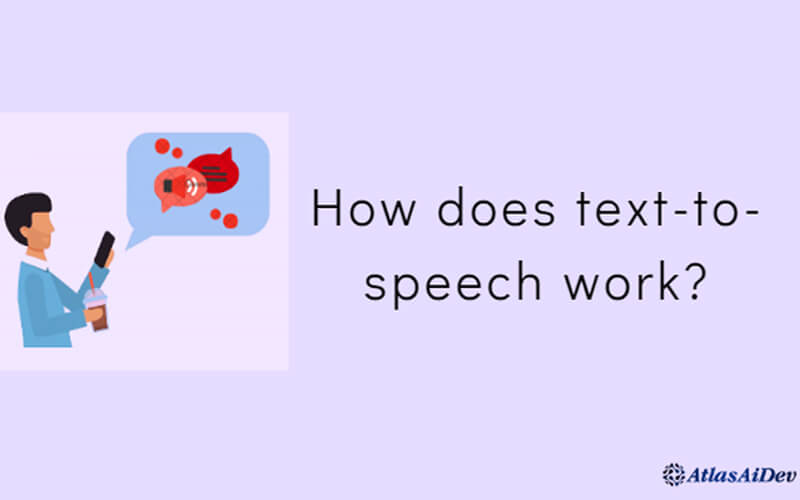Have you ever contemplated how text-to-speech works? How does text-to-speech technology help us for an impaired person? You use TTS, a common tool that you always meet in your ordinary life.
People use text-to-speech technology on mobile devices. When they ask the Google Assistant for instructions or turn on an audiobook to listen to it. TTS features help with reading for him. Text-to-speech technology uses artificial intelligence algorithms to convert written information into spoken words.
So, this significant technology has a variety of potential uses in various sectors. Such as accessibility, entertainment, and education.
If You read this article, then it will help you learn about it in more detail. So, let’s learn how text-to-speech technology works and how a person can use it to improve quality of life.
What is text-to-speech?
So, text-to-speech (TTS) is a fantastic technology. It converts written text into audio words. It bridgings the gap between spoken and written languages.
In simple words, this technology lets you listen to words. The major goal of this technology is to make information accessible to everyone. The purpose is to make it independent of learning style or visual impairment in life.
Suppose you are a person who is blind but willing to read a novel or read a book. But it is a sad moment for you when there is no supporting software or helpful tools for you. Isn’t it a regrettable matter for you? You can not read because of your blindness. That time you will feel like, I wish there was a tool that could read for me and audio it.
Seems interesting, doesn’t it?
Hence, TTS is one tool that is not only for blind people. But it also helps thousands of thousands of people in daily life.
For what reasons do readers or students use text-to-speech tools?
Text-to-speech for students is enhancing the learning process. Text-to-speech technology can benefit students who are impaired. And they have limited time to study and need to complete fast. As well as younger pupils who struggle with reading or pronouncing new words.
TTS is an effective learning aid for children with autism and emotional problems. TTS is used on any device and works on both text files and websites. Teachers get benefits from using text-to-speech. And they are increasingly using it in their classrooms.
Researchers state that text-to-speech technology aids student concentration and enhances subject understanding.
It increases not only children’s ability to remember things. But also upgrades their confidence and motivation.
Text-to-speech allows students’ progress to be monitored easily. It is easier for teachers and parents, as well as making them independent in learning.
Our daily lives are based on TTS, as it improves word recognition. It makes learners more likely to recognize and correct their errors.
People debate the superiority of audiobooks with voice actors over computer-generated voices. There is actually solid proof TTS is an extremely useful tool for students of all ages.
What technology is used in text-to-speech?
Through the use of text-to-speech (TTS) technology, written words are audible. Thus, this procedure typically involves a combination of linguistic, mathematical, and auditory elements. Linguistic components like words, phrases, and phonemes are extracted from the written text.
Here, NLP techniques determine the correct pronunciation, intonation, and accent for synthetic speech.
The voice synthesis system procreates the audio signals for this language input. These signals are created using either concatenative or parametric synthesis. These are the two common methods. Synthetic speech is output through speakers, headphones, or other devices.
Modern text-to-speech systems use RNNs and transformer models for better speech quality. Models are trained using large annotated datasets of text and voice to uncover intricate word patterns and connections.
However, Progress in algorithms, resources, and hardware enables expressive text-to-speech systems. TTS technology has flourished in various applications. Including language learning platforms, accessibility aids, and virtual assistants.
How does text-to-speech work?
Text-to-speech technology has two parts: the front end and the back end. Users engage with the front end, whereas AI is responsible for the back end. These two components are important for understanding how text-to-speech works. So, here we will explain more about them.
Let’s know about the front end of TTS (Text-to-speech) technology:
The front end is sometimes referred to as a text-to-speech interface. Which you have already used and seen in many applications. Here, all you have to do is enter the text, choose your choices (language, voice, tone, etc.), and click the convert button.
It leverages the API and plugins to automate the entire converting procedure. In minutes, you can read the material aloud.
About the back end in TTS technology:
The main action works on the back end. And the entire system is how the AI works in the background. Using the acoustic model, which typically deals with language and cognitive information. Here’s how it works.
Pre-Processor: The text on the screen is pre-processed and separated into words. This allowed the algorithm to better interpret the text’s pitch and tone.
Encoder: The words are then sent into the encoder input, where language elements process them. They implement part-of-speech tags, pronunciation tags, and grammatical structures to train the system.
Decoder: It then reaches the decoder. The text is analyzed using latent techniques and transformed into auditory characteristics.
Vocoder: The vocoder transforms acoustics into waveforms and produces speech.
How does Google text-to-speech work?
Google’s advancement in text-to-speech technology got a significant gain with the acquisition of DeepMind in 2014. This led to the development of WaveNet, one of the most advanced TTS systems by Google.
Google’s text-to-speech technology uses sophisticated algorithms and machine learning models.
When a user inputs text into any Google TTS service. It first checks for language, punctuation, and formatting.
After this first check, the system then uses natural language processing. To decide whether the correct intonation, and pronunciation for the spoken output or not.
The system then creates speech by combining pre-recorded snippets of human speech, recorded by voice actors. These snippets are carefully adjusted to sound natural and cover a wide range of intonations.
Here, the goal is to make the synthetic voice closely resemble real human speech. Using elements like emphasis, rhythm, and intonation to convey the right meaning and emotion.
Powerful neural network models, trained on vast amounts of data, lie at the core of this process. They help detect language patterns and produce accurate, expressive speech.
The result is a dynamic and adaptable TTS system. It delivers high-quality speech in various languages and accents. Making digital audio content more accessible and useful around the world.
How does Kindle text-to-speech work?
The Kindle’s text-to-speech technology reads e-books for you and it provides audio of the text using a computer-generated voice.
When you enable this feature on one of the Kindle e-readers or through the Kindle app. Then you will have the powerful speech synthesis technology. Which converts the written text into audio like a human person talking.
This feature offers an opportunity for readers to enjoy their favorite books. Perhaps if they are not willing to read, but ready to listen to the book. Users can change the pace it reads and even select other voices to make the experience personal to them.
Kindle’s text-to-speech technology applies advanced algorithms to analyze text structure.
The system makes written words sound natural when spoken.
Natural language processing is used to improve the computerized voice’s rhythm and intonation in the technology. being used. This process is making the resulting listening experience more engaging and immersive.
Kindle text-to-speech merges cutting-edge speech synthesis with e-book reader technology, providing a unique reading experience.Â
It improves access and enjoyment of the literature world.
FAQs
The major elements that makeup spoken language are text analysis, linguistic analysis, and audio signal processing.
Text-to-speech technology indeed perfectly adapts written material, such as documents, web pages, and ebooks, to spoken audio. So, if anyone is interested in converting their documents into text-to-speech, they can use it.
Text-to-speech accuracy is enhanced, and with advanced algorithms, naturalness, and understandability could reach high levels.
Yes, TTS can support and convert many languages, as modern text-to-speech systems can deal with many languages and dialects, resulting in multilingual synthesis.
So many places use TTS in our daily lives. Text-to-speech technology is used in accessibility software, language learning apps, navigation systems, voice assistants, and more places.
Users can alter the reading pace of the synthetic voice to match their desired pace.
Yes, this tool is continuously improving in natural language processing and artificial intelligence makes text-to-voice technologies better and allows for speech synthesis to be more of a quality simulation of human speech.
Conclusion
Text-to-speech (TTS) technology provides us with an important leap. Helping us in making information more accessible and useful technology for people. Whether it’s helping impaired people and improving student learning experiences.
Alternatively, by providing a hands-free method to consume material, TTS works to be a vital tool in our daily lives. TTS crosses the gap between reading and listening by converting written text into speech. It provides us with a good option for people with diverse requirements and preferences.
The future of text-to-speech (TTS) is bright. And, WordPress plugin Atlasvoice Text to Speech shaping the world. Where information is not only written.
But also communicated, heard, and understood by everybody. Why don’t you use this technology and let your website’s words be heard?



